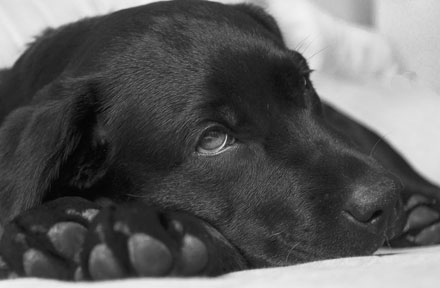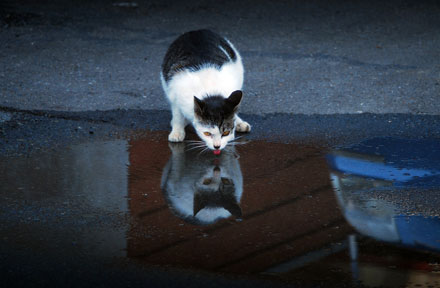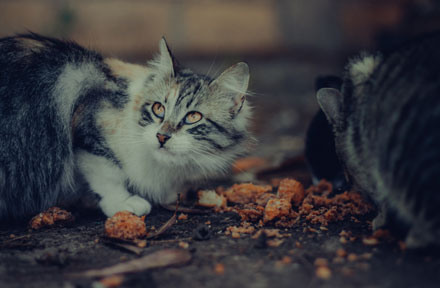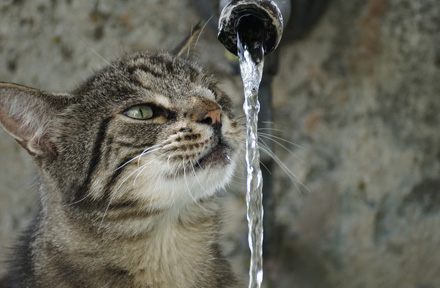Apr 14, 2025
Author:Amanda Lyu

Tortoiseshell cats are something special, and not just because they look like they’ve been painted by a tiny, feline Picasso. With their swirly coats of black, orange, and sometimes cream or gold, torties are total showstoppers. But here’s the fun part: “tortoiseshell” isn’t a breed. It’s actually a coat color pattern, created by a unique genetic mutation that gives them those beautiful mixed colors.
One thing all torties have in common? They’re basically walking works of art with a splash of attitude.
Now, one of the most common questions people ask is: “Are tortoiseshell cats male or female?”
Answer: Almost always female! It’s super rare to find a male tortie (like 1 in 3,000 rare). And the girls? They’ve got tortitude! A little bit of sass, a whole lot of independence, and personalities just as bold as their fur.
There’s even a sweet myth that says tortoiseshell cats bring good luck to the homes they join. That’s why they’re often nicknamed “money cats”, and honestly, we think they’re worth their weight in gold.
Whether you’re thinking of adopting one or just curious about what makes torties so lovable, we’ve rounded up some fun and fascinating Tortoiseshell cat facts that’ll make you fall head over paws for these quirky little queens.
Although coat colors, which are unique in tortoiseshell cats, are characteristics of tortoiseshell cats, they are available in breeds including:
● American Shorthair
● British Shorthair
● Persian
● Cornish Rex
● Maine Coon
The unique markings of the coat are an effect of an unusual combination of genes that exists almost entirely in female tortoiseshell cats. A tortoiseshell coat requires two X chromosomes, one containing the black gene and one with the red gene. Male tortoiseshell cats thus occur infrequently and are often sterile due to an additional X chromosome.
Two torties are never alike since every cat has a unique pattern of color distribution on its fur. Their scarcity is part of what makes them so desirable and mysterious, thereby making them ideal companions for cat enthusiasts.
For centuries, myths and legends have been around tortoiseshell cats. The animals are considered lucky symbols in many cultures:
Khmer legend in Southeast Asia claims tortoiseshell cats were born of blood from a young goddess.
Torties brought good luck to Europe's ancient Celtic beliefs.
From an English legend, rubbing a wart on a tortoiseshell cat's tail would allegedly cure it.
In Japanese tradition, tortoiseshell cats can ward off ghosts and safeguard homes.
According to the Scottish and Irish superstition, the home becomes fortunate if such a cat considers that house its home.
They are money cats in America, as they can bring a lot of abundance.
The fascinating history, dramatic looks, and stubborn personality of the tortoiseshell cats have made them legends among cat fanciers.
Most people get the tortoiseshell cats confused with the calico, though. Calico is white at the back, always with orange and black patching, while torties are usually a more blended or brindle mix of orange, black, and often white. Torties can also have varying pattern types:
● Patched torties have well-defined patches of color.
● Brindle torties have a more interwoven combination of colors.
● Torbies (tortoiseshell-tabby mix) possess tabby stripes on their tortie coat.
● Chimera torties possess a dramatic two-tone face with a split face of two colors.
Their eyes may also be differentiated, from hazel and amber to green, but the correlation between the eye and coat color is indirect.
Cat lovers believe that torties have the most extroverted and vivacious characters, pointing them out as lively creatures. They characterize its temperament as merely a minus word for "tortitude".
The female tortoiseshell cats are full of energy and enjoy interacting with others in play.
Most of the time, they say what they need to say in sweet-sounding meows and purrs.
They treasure the time they invest in themselves but form a solid connection with their very selected humans.
The female tortoiseshell cats do as they please, and they tell it like it is. Even with all of their attitude, they can also be very affectionate and dedicated to their owners.
According to a University of California, Davis study, tortoiseshell and calico cats tend to swat at, bite, or hiss at people. It indicates the hot temper associated with these cats. Of course, none of this demonstrates their attitude towards humans, forming strong attachments with humans and being loyal.
Various breeds constitute tortoiseshell cats, but their nutty and rewarding task is the same as any other cat. To maintain your tortie healthy and happy:
● Feed a balanced diet appropriate for age and level of activity.
● Schedule annual vet visits for checkups and inoculations.
● Provide daily playtime to keep him physically stimulated and entertained.
● Offer stimulating toys and scratching posts that tempt this inquisitive animal.
● Respect independence by giving your cat time alone whenever it wants it.
● Keep the interest going by changing toys and offering climbing structures.
Torties do well in environments established for their physical and psychological needs, keeping them spry and loving companions.
Tortoiseshells are not a breed of cats. Bright-colored hair in itself does not pose any ill effects. However, the life expectancy of a tortoiseshell cat can be affected by diet, lifestyle, and subspecies. So, indoor tortoiseshell cats can live up to 17 years. Outdoor tortoiseshell cats survive only for around 2-5 years because of death from external causes.
Male tortoiseshell cats are rare and typically possess an additional X chromosome (XXY genetic makeup), leading to the clinical syndrome of Klinefelter syndrome, where there is reduced muscle power, joint pain, and susceptibility to many health conditions.
Here are some fun, fascinating, and heart-melting facts about these fiery felines that’ll make you fall in love with them even more:
Despite what the name might suggest, “tortoiseshell” doesn't refer to a breed, it’s all about the coat pattern. These multicolored beauties are named after the dazzling shell of a tortoise, and their fur usually swirls with shades of black, orange, brown, and gold.
Throughout history, tortoiseshell cats have been wrapped in a little bit of magic. In Japanese folklore, they’re believed to protect homes from ghosts, and in the U.S., they’ve earned the adorable nickname “money cats” for bringing luck and prosperity. Who wouldn’t want a lucky little purring charm curled up on their couch?
Here’s where science steps in: the color of a cat’s coat is linked to the X chromosome. Female cats have two X chromosomes (XX), so they can carry both black and orange coloring—perfect for creating that tortie patchwork.
Males, on the other hand, usually have only one X and one Y (XY), so having both tortie colors is super rare. For a male to be born with tortoiseshell coloring, he needs an extra X chromosome (XXY), which makes him sterile and often comes with health issues. It’s estimated that only 1 in every 3,000 tortoiseshell cats is male. Total unicorn energy.
Torties come in all kinds of fabulous patterns—from bold patches to delicate brindles. And if you spot one with tortoiseshell colors and tabby stripes? That’s a “torbie,” and yes, the name is just as cute as the cat.
Their eyes are just as magical—ranging from gold to green to hazel. While science hasn’t found a proven link between coat color and temperament, most tortie lovers agree: these cats have big personalities. Independent, opinionated, and a little dramatic? That’s just tortitude.
If you’ve ever lived with a tortie, you’ve probably experienced “tortitude”—a sassy, strong-willed vibe that seems to come standard with that marbled coat. They’re not afraid to speak their mind, whether it’s demanding dinner right now or choosing which window gets their royal attention today.
They’re loving, loyal, and playful—but on their terms. Basically, they’re queens (or kings, in very rare cases) and expect to be treated as such. You’ve been warned.
From their unique genetics to their striking looks and cultural legends, tortoiseshell cats are unlike any other. They may be a bit high-maintenance or spicy at times, but that’s part of their charm.
Whether you’re lucky enough to live with a tortie or still dreaming of the day you meet one, there’s no denying it—they’re a whole personality wrapped in fur, and you’ll never be bored with one around.
Each tortie is unique in personality. Yet, the socialization and age of these cats will determine how they treat children and other animals. Some torties are friendly and very playful and can make excellent companion pets for kids, but others prefer to be alone.
When adding a tortie to a multi-cat household, easing the pet slowly and rewarding it with praise, toys, and accessories will ensure the transition goes smoothly. We should provide distinct areas for play, food, and rest so they feel safer sharing a space.
Tortoiseshell cats really are in a league of their own. From their striking, patchy coats to their bold, no-nonsense personalities, torties are endlessly fascinating and full of surprises. Sure, they’ve got a bit of sass and might pretend not to care sometimes, but don’t be fooled. Torties often form strong, lasting bonds with their humans, and once you're their person, you're in for life.
These cats are full of personality, and they love their routines just as much as their independence. Want to keep your tortie happy (and avoid the side-eye)? Try setting up a WOpet automatic feeder to keep meals on schedule—even if you're sleeping in. And to make sure she stays hydrated in the most stylish way, WOpet’s Ceramic Wireless Pet Water Fountain is practically made for picky little queens who prefer their water fresh and flowing.
Got a sassy little tortie at home? Treat her like the queen she is with WOpet’s purrfect cat essentials. At the end of the day, living with a tortoiseshell cat means lots of laughs, a little attitude, and a whole lot of love. And really, who could ask for more?
Frequently Asked Questions
A tortoiseshell cat has been characterized as being a bit cranky, bossy, and occasionally having fun with it-"tortitude." However, a cat's personality can be too varied, and temperament is more a matter of individual personality, environment, and handling than of regard for coat color.
Not all breeds of cats are hypoallergenic. It's not the coat color that's responsible for the allergy; it's just that the dander or the saliva actually are the allergens. Because tortoiseshell kittens are mixed breeds, they will develop different allergies.
No. Torties and calicos are distinct breeds of cats. Torties are black and orange, and calicos are white but not large patches.
The pure or mixed breed probably has a say in its pricing. A more or less fifty to two-hundred-dollar madam can be adopted from a shelter. Real tortoiseshell cats may run you anywhere from several hundred dollars to several thousand dollars, depending on what breed it fall under.
Label:
Popular Post

What to Feed a Sick Dog With No Appetite? [2025 Guide]
May 16, 2023

Troubleshooting Common Issues with Automatic Pet Feeders: Tips & Tricks for Pet Owners
Oct 26, 2023

Why Does My Cat Cough After Drinking Water? 8 Potential Reasons
Mar 13, 2023

My Cat Only Eats A Little at A Time - What to Do?
Feb 27, 2023

Why is My Cat Throwing up Water? Top 5 Causes Here
Feb 08, 2023
$99.99
$129.99
Copyright © 2025 WOPET. All Rights Reserved.